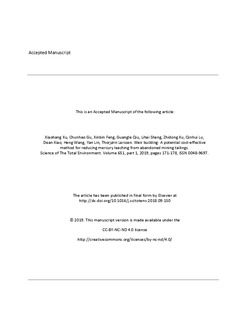Weir building: A potential cost-effective method for reducing mercury leaching from abandoned mining tailings
Xu, Xiaohang; Gu, Chunhao; Feng, Xinbin; Qiu, Guangle; Shang, Lihai; Xu, Zhidong; Lu, Qinhui; Xiao, Dean; Wang, Heng; Lin, Yan; Larssen, Thorjørn
Journal article, Peer reviewed
Accepted version
Date
2019Metadata
Show full item recordCollections
- Publikasjoner fra Cristin - NIVA [2160]
- Scientific publications [1172]
Original version
Science of the Total Environment. 2019, 651 (Part 1), 171-178. 10.1016/j.scitotenv.2018.09.150Abstract
To mitigate mercury (Hg) pollution and reduce Hg transportation downstream, a
weir was designed across a river system impacted by leachate from the slagheap of
the Yanwuping Hg mine in Wanshan Hg mining area. A whole year monitoring of Hg
species was conducted, and the efficiency of Hg reduction by the weir application was
evaluated. The Hg concentrations in river water were significantly higher during the
wet season than during the dry season. Waterflow was confirmed to be the main
driving factor for Hg mobilization and transportation, and an episode study revealed
that most Hg was released during storms. Increased monitoring and preventive
maintenance work should be performed on barriers in advance of storms. A large
fraction of total Hg (THg) and methylmercury (MeHg) is associated to particles.
During the study period, approximately 412 g THg and 4.04 g total MeHg (TMeHg)
were released from the YMM slagheap, of which 167 g THg and 1.15 g TMeHg were
retained by the weir. Annually, 40.4% THg and 38.4% TMeHg was retained by the
weir. Weir construction is considered as a potential cost-effective measure to mitigate
Hg in river water and should be promoted and extended in the future after
optimization.
Description
Embargo until 12 Sept 2020

